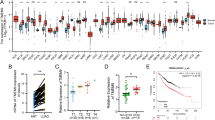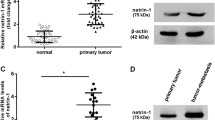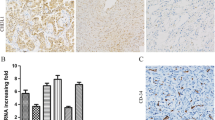Abstract
Background
Angiogenesis is an important process required for tumor progression. Mucin 1 (MUC1) is a transmembrane glycoprotein that is aberrantly upregulated in many types of cancer, including non-small-cell lung cancer (NSCLC). However, the biological significance of MUC1 overexpression in lung cancer angiogenesis is not completely understood.
Methods
We showed that enforced expression of MUC1 in two NSCLC cell lines, A549 and NCI-H460, which have a low level of endogenous MUC1, promoted their ability to induce vascular endothelial growth factor (VEGF)-dependent endothelial cell migration and tube formation.
Results
There was a significant increase in VEGF expression in MUC1-overexpressing NSCLC cells. Moreover, MUC1 overexpression resulted in a marked elevation in phosphorylated Akt and extracellular signal-regulated kinase (ERK)1/2, indicative of activation of both signaling pathways. Most importantly, inhibition of Akt or ERK signaling using specific chemical inhibitors restrained the proangiogenic activity of MUC1-overexpressing NSCLC cells.
Conclusions
Taken together, our present data demonstrate that the aberrant upregulation of MUC1 favors tumor angiogenesis in NSCLC, likely through the activation of both Akt and ERK pathways and elevation of VEGF production. MUC1 may thus be a potential antiangiogenic target in NSCLC.





Similar content being viewed by others
References
Jemal A, Center MM, DeSantis C, Ward EM (2010) Global patterns of cancer incidence and mortality rates and trends. Cancer Epidemiol Biomark Prev 19:1893–1907
Yang P, Allen MS, Aubry MC, Wampfler JA, Marks RS, Edell ES, Thibodeau S, Adjei AA, Jett J, Deschamps C (2005) Clinical features of 5,628 primary lung cancer patients: experience at Mayo Clinic from 1997 to 2003. Chest 128:452–462
Bunn PA Jr (2002) Chemotherapy for advanced non-small-cell lung cancer: Who, what, when, why? J Clin Oncol 20:23S–33S
Schiller JH, Harrington D, Belani CP, Langer C, Sandler A, Krook J, Zhu J, Johnson DH, Eastern Cooperative Oncology Group (2002) Comparison of four chemotherapy regimens for advanced non-small-cell lung cancer. N Engl J Med 346:92–98
Sandler A, Gray R, Perry MC, Brahmer J, Schiller JH, Dowlati A, Lilenbaum R, Johnson DH (2006) Paclitaxel-carboplatin alone or with bevacizumab for non-small-cell lung cancer. N Engl J Med 355:2542–2550
Gendler SJ, Spicer AP (1995) Epithelial mucin genes. Annu Rev Physiol 57:607–634
Ligtenberg MJ, Kruijshaar L, Buijs F, van Meijer M, Litvinov SV, Hilkens J (1992) Cell-associated episialin is a complex containing two proteins derived from a common precursor. J Biol Chem 267:6171–6177
Kufe DW (2009) Functional targeting of the MUC1 oncogene in human cancers. Cancer Biol Ther 8:1197–1203
Jonckheere N, Van Seuningen I (2010) The membrane-bound mucins: from cell signalling to transcriptional regulation and expression in epithelial cancers. Biochimie 92:1–11
Kim YS, Gum, Brockhausen I (1996) Mucin glycoproteins in neoplasia. Glycoconj J 13:693–707
Aloysius MM, Zaitoun AM, Awad S, Ilyas M, Rowlands BJ, Lobo DN (2010) Mucins and CD56 as markers of tumour invasion and prognosis in periampullary cancer. Br J Surg 97:1269–1278
Aubert S, Fauquette V, Hémon B, Lepoivre R, Briez N, Bernard D, Van Seuningen I, Leroy X, Perrais M (2009) MUC1, a new hypoxia inducible factor target gene, is an actor in clear renal cell carcinoma tumor progression. Cancer Res 69:5707–5715
Creaney J, Segal A, Sterrett G, Platten MA, Baker E, Murch AR, Nowak AK, Robinson BW, Millward MJ (2008) Overexpression and altered glycosylation of MUC1 in malignant mesothelioma. Br J Cancer 98:1562–1569
Retterspitz MF, Mönig SP, Schreckenberg S, Schneider PM, Hölscher AH, Dienes HP, Baldus SE (2010) Expression of {beta}-catenin, MUC1 and c-met in diffuse-type gastric carcinomas: correlations with tumour progression and prognosis. Anticancer Res 30:4635–4641
Situ D, Wang J, Ma Y, Zhu Z, Hu Y, Long H, Rong T (2010) Expression and prognostic relevance of MUC1 in stage IB non-small cell lung cancer. Med Oncol. doi: 10.1007/s12032-010-9752-4
Gao J, McConnell MJ, Yu B, Li J, Balko JM, Black EP, Johnson JO, Lloyd MC, Altiok S, Haura EB (2009) MUC1 is a downstream target of STAT3 and regulates lung cancer cell survival and invasion. Int J Oncol 35:337–345
Di Domenico M, Ricciardi C, Fusco A, Pierantoni GM (2011) Anti-VEGF therapy in breast and lung mouse models of cancers. J Biomed Biotechnol 2011:947928
Giatromanolaki A, Koukourakis MI, Sivridis E, O’Byrne K, Cox G, Thorpe PE, Gatter KC, Harris AL (2000) Coexpression of MUC1 glycoprotein with multiple angiogenic factors in non-small cell lung cancer suggests coactivation of angiogenic and migration pathways. Clin Cancer Res 6:1917–1921
Li X, Wang L, Nunes DP, Troxler RF, Offner GD (2003) Pro-inflammatory cytokines up-regulate MUC1 gene expression in oral epithelial cells. J Dent Res 82:883–887
Su H, Joho S, Huang Y, Barcena A, Arakawa-Hoyt J, Grossman W, Kan YW (2004) Adeno-associated viral vector delivers cardiac-specific and hypoxia-inducible VEGF expression in ischemic mouse hearts. Proc Natl Acad Sci USA 101:16280–16285
Shao ES, Lin L, Yao Y, Boström KI (2009) Expression of vascular endothelial growth factor is coordinately regulated by the activin-like kinase receptors 1 and 5 in endothelial cells. Blood 114:2197–2206
Carmeliet P (2000) Mechanisms of angiogenesis and arteriogenesis. Nat Med 6:389–395
Cook KM, Figg WD (2010) Angiogenesis inhibitors: current strategies and future prospects. CA Cancer J Clin 60:222–243
Arsham AM, Plas DR, Thompson CB, Simon MC (2004) Akt and hypoxia-inducible factor-1 independently enhance tumor growth and angiogenesis. Cancer Res 64:3500–3507
Zhang Y, Jiang X, Qin X, Ye D, Yi Z, Liu M, Bai O, Liu W, Xie X, Wang Z, Fang J, Chen Y (2010) RKTG inhibits angiogenesis by suppressing MAPK-mediated autocrine VEGF signaling and is downregulated in clear-cell renal cell carcinoma. Oncogene 29:5404–5415
Khodarev N, Ahmad R, Rajabi H, Pitroda S, Kufe T, McClary C, Joshi MD, MacDermed D, Weichselbaum R, Kufe D (2010) Cooperativity of the MUC1 oncoprotein and STAT1 pathway in poor prognosis human breast cancer. Oncogene 29:920–929
Woenckhaus M, Merk J, Stoehr R, Schaeper F, Gaumann A, Wiebe K, Hartmann A, Hofstaedter F, Dietmaier W (2008) Prognostic value of FHIT, CTNNB1, and MUC1 expression in non-small cell lung cancer. Hum Pathol 39:126–136
Kaira K, Murakami H, Serizawa M, Koh Y, Abe M, Ohde Y, Takahashi T, Kondo H, Nakajima T, Yamamoto N (2011) MUC1 expression in thymic epithelial tumors: MUC1 may be useful marker as differential diagnosis between type B3 thymoma and thymic carcinoma. Virchows Arch 458(5):615–620
Guddo F, Giatromanolaki A, Patriarca C, Hilkens J, Reina C, Alfano RM, Vignola AM, Koukourakis MI, Gambacorta M, Pruneri G, Coggi G, Bonsignore G (1998) Depolarized expression of episialin (EMA, MUC1) in lung adenocarcinoma is associated with tumor progression. Anticancer Res 18:1915–1920
Ohgami A, Tsuda T, Osaki T, Mitsudomi T, Morimoto Y, Higashi T, Yasumoto K (1999) MUC1 mucin mRNA expression in stage I lung adenocarcinoma and its association with early recurrence. Ann Thorac Surg 67:810–814
Ren J, Agata N, Chen D, Li Y, Yu WH, Huang L, Raina D, Chen W, Kharbanda S, Kufe D (2004) Human MUC1 carcinoma-associated protein confers resistance to genotoxic anticancer agents. Cancer Cell 5:163–175
Papadopoulos I, Sivridis E, Giatromanolaki A, Koukourakis MI (2001) Tumor angiogenesis is associated with MUC1 overexpression and loss of prostate-specific antigen expression in prostate cancer. Clin Cancer Res 7:1533–1538
Khodarev NN, Pitroda SP, Beckett MA, MacDermed DM, Huang L, Kufe DW, Weichselbaum RR (2009) MUC1-induced transcriptional programs associated with tumorigenesis predict outcome in breast and lung cancer. Cancer Res 69:2833–2837
Kawano T, Ahmad R, Nogi H, Agata N, Anderson K, Kufe D (2008) MUC1 oncoprotein promotes growth and survival of human multiple myeloma cells. Int J Oncol 33:153–159
Udhayakumar G, Jayanthi V, Devaraj N, Devaraj H (2007) Interaction of MUC1 with beta-catenin modulates the Wnt target gene cyclinD1 in H. pylori-induced gastric cancer. Mol Carcinog 46:807–817
Raina D, Kosugi M, Ahmad R, Panchamoorthy G, Rajabi H, Alam M, Shimamura T, Shapiro GI, Supko JG, Kharbanda S, Kufe DW (2011) Dependence on the MUC1-C oncoprotein in non-small cell lung cancer cells. Mol Cancer Ther 10(5):806–816
Wang H, Lillehoj EP, Kim KC (2004) MUC1 tyrosine phosphorylation activates the extracellular signal-regulated kinase. Biochem Biophys Res Commun 321:448–454
Dai R, Chen R, Li H (2009) Cross-talk between PI3K/Akt and MEK/ERK pathways mediates endoplasmic reticulum stress-induced cell cycle progression and cell death in human hepatocellular carcinoma cells. Int J Oncol 34:1749–1757
Gervais M, Dugourd C, Muller L, Ardidie C, Canton B, Loviconi L, Corvol P, Chneiweiss H, Monnot C (2006) Akt down-regulates ERK1/2 nuclear localization and angiotensin II-induced cell proliferation through PEA-15. Mol Biol Cell 17:3940–3951
Wang CC, Cirit M, Haugh JM (2009) PI3K-dependent cross-talk interactions converge with Ras as quantifiable inputs integrated by Erk. Mol Syst Biol 5:246
Acknowledgment
This study was supported by Key Medical Research and Technology Program of Educational Commission of Henan of China (No. 2009A320041).
Conflict of interest
All authors declare that there is no conflict of interest.
Author information
Authors and Affiliations
Corresponding author
Rights and permissions
About this article
Cite this article
Yao, M., Zhang, W., Zhang, Q. et al. Overexpression of MUC1 Enhances Proangiogenic Activity of Non-Small-Cell Lung Cancer Cells Through Activation of Akt and Extracellular Signal-regulated Kinase Pathways. Lung 189, 453–460 (2011). https://doi.org/10.1007/s00408-011-9327-y
Received:
Accepted:
Published:
Issue Date:
DOI: https://doi.org/10.1007/s00408-011-9327-y




